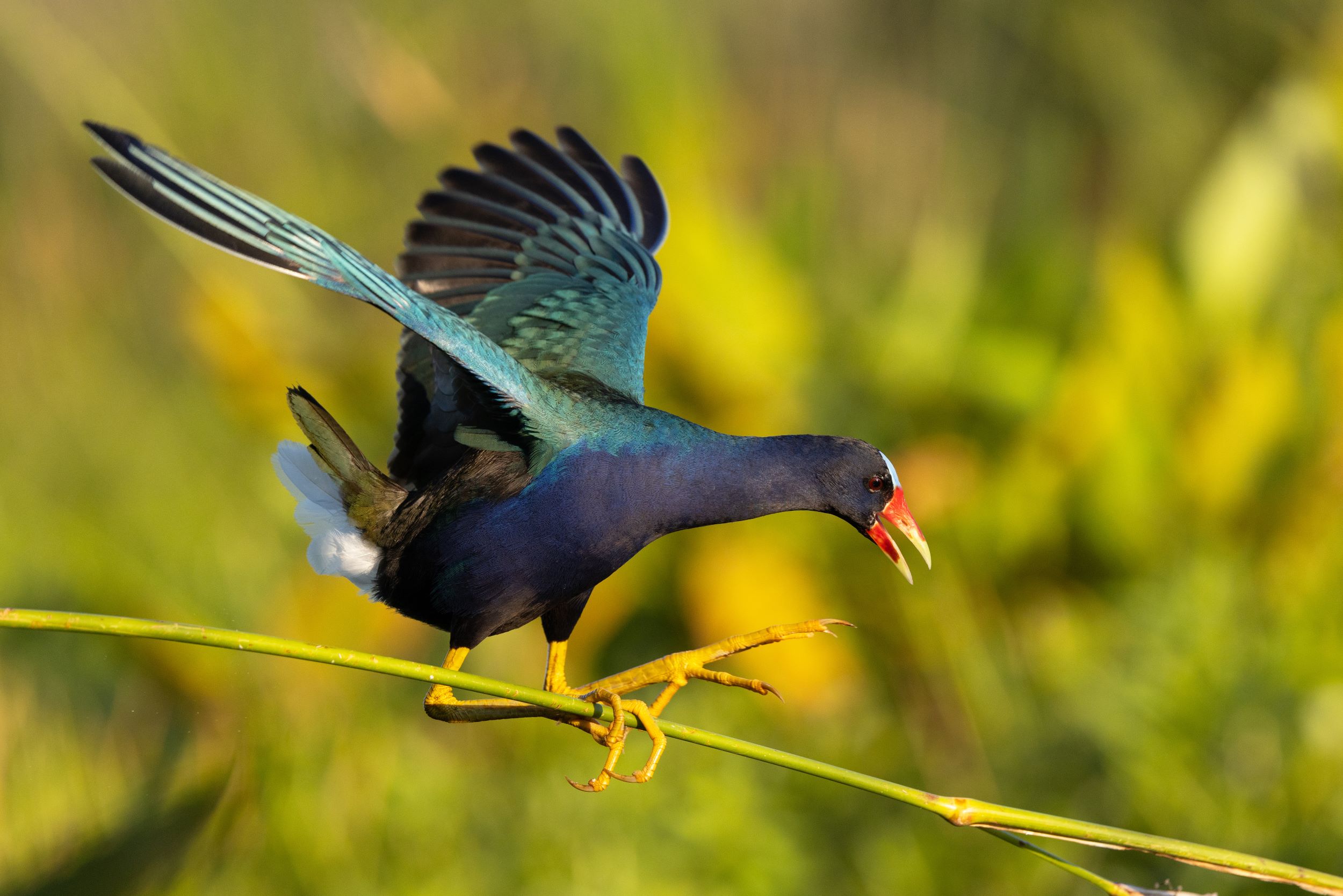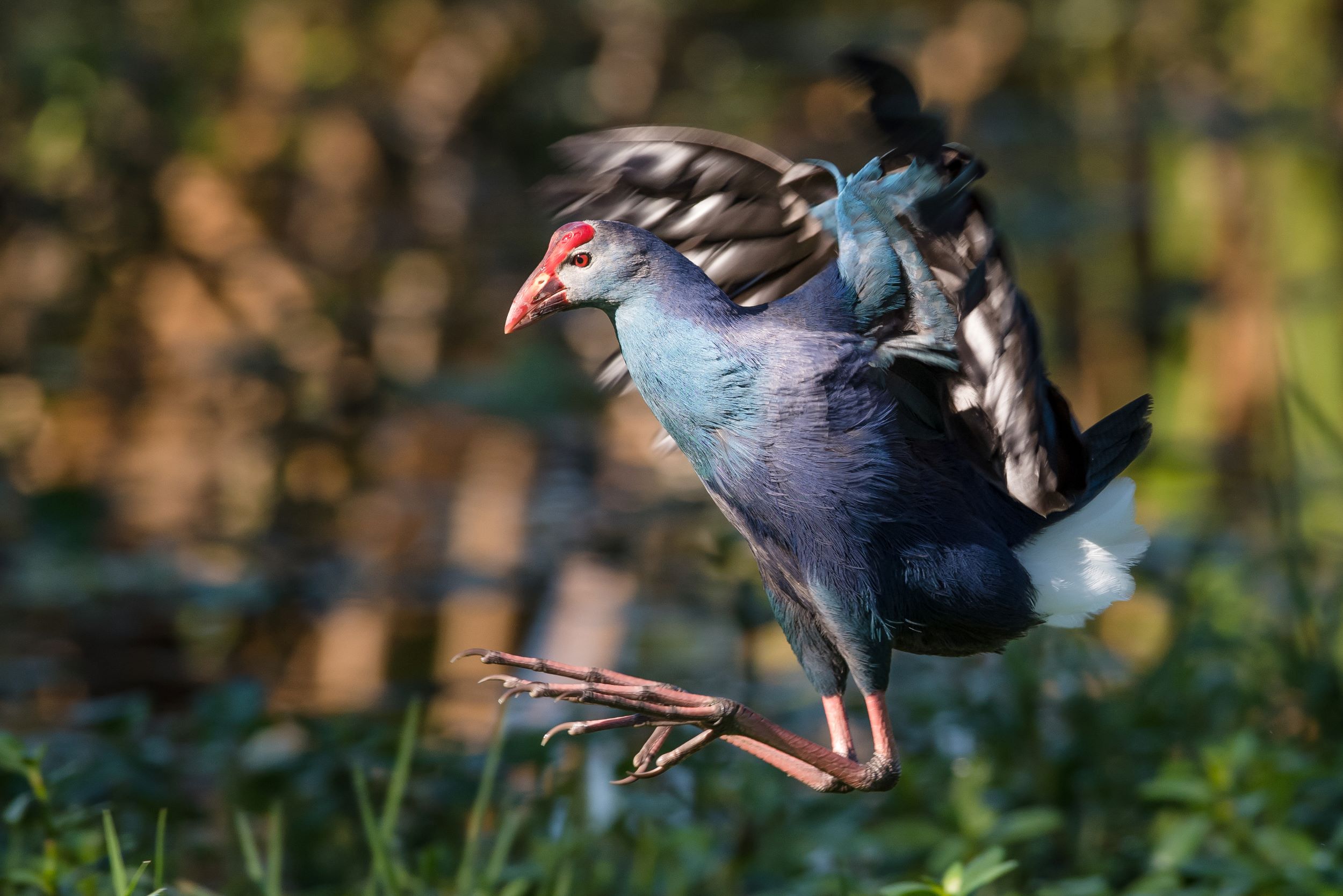
The Purple Gallinule
The Purple Gallinule, a vibrantly colored bird typically found in the southeastern United States, is a rare and unexpected visitor to Utah. With its striking plumage, long yellow legs, and distinctive frontal shield, the Purple Gallinule (Porphyrio martinicus) is an accidental species in Utah, appearing only in extremely rare instances. This bird, native to warmer and more humid climates, primarily inhabits freshwater wetlands where it forages among floating vegetation.
The presence of Purple Gallinules in Utah is so rare that each sighting becomes a significant event for the state’s birdwatching community. One such notable instance occurred on July 24, 2004, at the Jordanelle Wetlands, a momentous observation given the bird’s usual range. Before this sighting, the last recorded appearance of a Purple Gallinule in Utah was in 1939 in Salt Creek Canyon, east of Nephi. These sporadic sightings, decades apart, underscore the rarity of this species in Utah and the excitement they generate among birdwatchers and ornithologists.

Purple Gallinules are typically associated with warm, marshy environments rich in vegetation, such as those found in the southeastern United States and Central and South America. They are known for their ability to walk on floating vegetation, thanks to their long toes, which distribute their weight effectively. This adaptation allows them to feed on aquatic plants, seeds, insects, and small aquatic creatures. Their bright plumage, with iridescent blue, green, and purple feathers, along with a striking red and yellow bill and frontal shield, makes them a visually captivating species.
The accidental presence of Purple Gallinules in Utah is likely due to vagrancy, where individual birds venture far outside their typical range. Factors contributing to vagrancy in birds can include weather patterns, such as strong storms that displace birds, or navigational errors during migration. When such vagrant individuals appear in Utah, it offers a rare opportunity for local birdwatchers to observe a species that is otherwise unlikely to be seen in the region.
For birdwatchers hoping to catch a glimpse of a Purple Gallinule in Utah, it requires a combination of luck and timing. Given the rarity of sightings and the unpredictability of vagrant occurrences, there are no specific times or locations where one can reliably expect to see this species. However, keeping informed about recent bird sightings through local birdwatching networks and online birding communities can increase the chances of spotting these rare visitors. The Jordanelle Wetlands and other wetland areas in Utah, while not typical habitats for Purple Gallinules, could be potential sites for such accidental sightings, especially during the warmer months when migratory movements are more common.
In conclusion, the Purple Gallinule’s presence in Utah is a rare and intriguing phenomenon, offering a glimpse into the complexities of bird migration and the occasional surprises that nature has in store. For those fortunate enough to observe this striking bird in Utah, it is an unexpected and memorable wildlife encounter, adding a touch of tropical color to the state’s diverse avian tapestry.
The Binoculars that we Recommend
The Vortex Optics Diamondback HD Binoculars 10x42 are a top choice for birdwatching enthusiasts, particularly for observing majestic birds like eagles. These binoculars are designed to offer exceptional clarity and color accuracy, making them ideal for spotting and identifying birds in various environments. The 10x42 model, with its 10x magnification and 42mm objective lenses, provides a wide field of view and brings distant subjects closer with remarkable detail, crucial for birdwatchers who need to observe from a respectful distance. The high-definition optical system, enhanced with dielectric coatings, ensures bright, clear, and color-accurate images, even in low-light conditions. This feature is particularly beneficial during early morning or late evening birdwatching sessions. The rugged build of the Diamondback HD Binoculars, coupled with their rubber armor, provides a secure, non-slip grip, and durable external protection. They are also waterproof and fog-proof, thanks to the argon purging and O-ring seals, making them reliable in various weather conditions. This durability is essential for birdwatching events, where equipment may be exposed to diverse outdoor elements. Lightweight and ergonomically designed, these binoculars are comfortable for extended use, a crucial factor during lengthy birdwatching excursions or events. Overall, the Vortex Optics Diamondback HD Binoculars 10x42 are a superb tool for avid birdwatchers and nature guides, offering the perfect combination of optical performance, durability, and user comfort for observing eagles and other wildlife.
These are the binoculars we carry when leading events.
As part of the Amazon Services LLC Associates Program, an affiliate advertising initiative, our website offers a way for us to earn commissions by linking to Amazon.com and its affiliated sites. When you click on an Amazon affiliate link on our site and make a purchase, we receive a small commission. This comes at no extra cost to you. This program helps us continue providing valuable content while offering you a seamless shopping experience.
